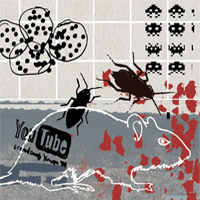A clean restaurant will keep the pests away and guests in play
Two years ago, shocked passersby gaped in horror as several rats scurried across the countertop of Happy Seven, a popular restaurant in Toronto’s Chinatown district. Then, last year, executives from the QSR giant Domino’s Pizza were hurdled into a public relations nightmare when a video of an employee purposely contaminating food, by rubbing it against his backside and nostrils, surfaced on YouTube.
Deplorable employee behaviour is hard enough to deal with, but less publicized pest and sanitation issues can be just as deadly to an operation’s bottom line and reputation, a reminder that both should remain top-of-mind at any foodservice establishment. In fact, being vigilant and proactive with staff procedure will save time, money and — most importantly — customer trust.
To start, a good sanitation program is the most integral part of any pest control plan; the two are intertwined since an unclean environment attracts everything from fruit flies to rats. “You have to clean the invisible,” insists Mike Byerley, director of Quality Assurance at Compass Group Canada. “Look behind and under equipment. Have a master cleaning schedule in place, use it and follow it.”
The checklist of cleaning do’s and don’ts is long. “Everything has to be six inches or more off the floor,” explains Byerley. “The best way to keep everything sanitized is to clean as you go. Don’t kick something under the counter and think you’ll clean it up later. Later never comes.” He also recommends keeping trash bins sealed tight, away from the building and removing items from cardboard boxes, which can sometimes house cockroaches and other insects.
Cleaning can be a little easier for managers and owners of chains and franchises who can consult with experts employed by the brand. Such experts may offer affordable, or even complimentary, materials such as sanitizers and disinfectants customized to the store’s needs. Often, there’s also training on how and when (daily, weekly, monthly, et cetera) to use each product, explains Steve Lawrence, assistant director of Operations for Subway.
As for cleaning practices, Lawrence echoes Byerley’s sentiments. “Employees should be thoroughly trained and should know how to use cleaning chemicals,” he says. “They should also have a checklist of what needs to be done and when to do it.” Simply put, a checklist should tell employees everything from when mopping should be done to when food should be checked for expiry dates. If everyone can see a clear list of tasks and duties, including explicit directions on how and when they should be performed, they’ll be more likely to clean thoroughly.
Training, either through a third-party company or the municipal public health department, is another affordable option. But, employers who are hoping to avoid a crisis, like the one that took place last year at Domino’s, should consider random inspections and rewards for exemplary work. “Recognize people for a job well done,” says Scott McDeivitte, a foodservice advisor with Gordon Food Services (GFS). “If you have a good inspection, maybe give a small bonus to those involved.” To safequard against inadequate practices, Subway employs a unique version of the “secret shopper” method with field consultants evaluating stores monthly.
Once your sanitation plan is in motion, it’s important to remain vigilant. Rats in your storefront window will obviously frighten potential customers, but pests aren’t always in clear view. “Look for rodent droppings and gnawed-on materials,” says Mike Brown, senior marketing manager at Ecolab. “By following proper procedure, there can be early detection.”
And, among other things, early detection could prevent illness. Rodents can carry Hantavirus and, just like unsanitary food and equipment, their feces can transmit hazardous bacteria such as salmonella and E. coli.
Still, it’s important to consult an expert when you spot trouble. “Don’t try to handle a pest problem yourself,” asserts Brown. Even before pests appear, all foodservice management should be familiar with a registered, reputable pest-control operator. “There’s PCO and Abell and other companies,” says Byerley. “[Be mindful of companies] that don’t offer any solutions other than sprays or traps. They should be educating you as well.”
Treatment will depend on the type of pest, as ants are handled differently than mice or rats. Still, some experts warn to be wary of snap and glue traps that often kill — sometimes inhumanely — rodents, leaving decomposing bodies that are likely to spread harmful bacteria before the remains can be disposed. Pest-control experts can explain how to handle live vermin or kill traps and poisons while determining the type of treatment your facility needs.
If it’s too late, and a mouse has been spotted in the dining room or an employee has been caught with dirty hands, damage control could be your last hope for monetary — and emotional — salvation.
“From a restaurant point-of-view, it’s a tough one,” says GFS’s McDeivitte, while discussing the best way to react to a sanitation-related emergency. He adds: “Open up your kitchen to both auditors and customers. Do not hide the problem.”
With food-safety news going viral on the web, the best damage control is transparency and genuine accountability. “Follow-up and don’t try to hide it,” Subway’s Lawrence says, echoing McDeivitte. “Don’t make excuses, just fix the problem, and get the support of your local health department and follow through on their guidelines. The public will read into it what they want. No matter what you say, you won’t change their minds, so focus on fixing the problems instead.”
After the sanitation debacle at Domino’s, company president Patrick Doyle released his own YouTube video featuring a sincere apology, explanation and assurance that the offending employees had been terminated and their North Carolina store closed for investigation. The video didn’t recharge the company’s image overnight, but a study conducted by the New Jersey-based HCD Research Inc., determined that Doyle’s apology did placate a small number of ambivalent respondents. Sometimes, monitoring — and using — social media is the best way to share progress and, hopefully, regain consumers’ confidence. Happy Seven — like several other restaurants in the area that were closed after inspections turned up rodents — didn’t take as active a PR approach and remains closed.
“Don’t just say you’re going to fix it, do it,” warns Ecolab’s Brown. “You have to show people that your operation has 360 degrees of protection. Communicate, reach out, prove, persuade and illustrate. Show off pictures of shimmering stainless steel and an award-winning bathroom. Show off your commitment.”
Illustration by Gary Sawyer





















